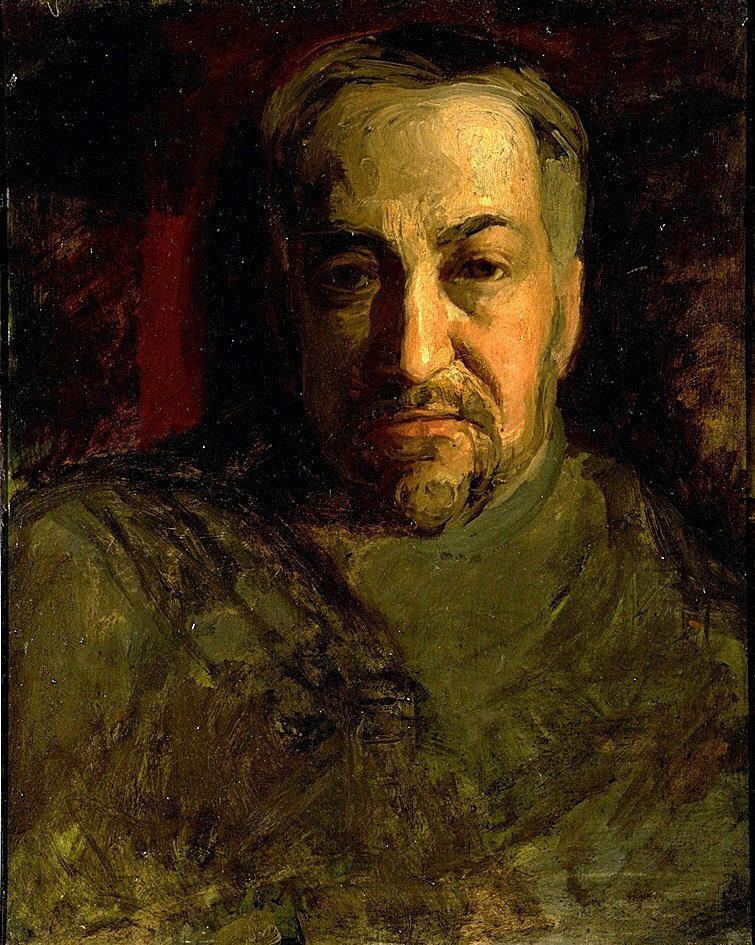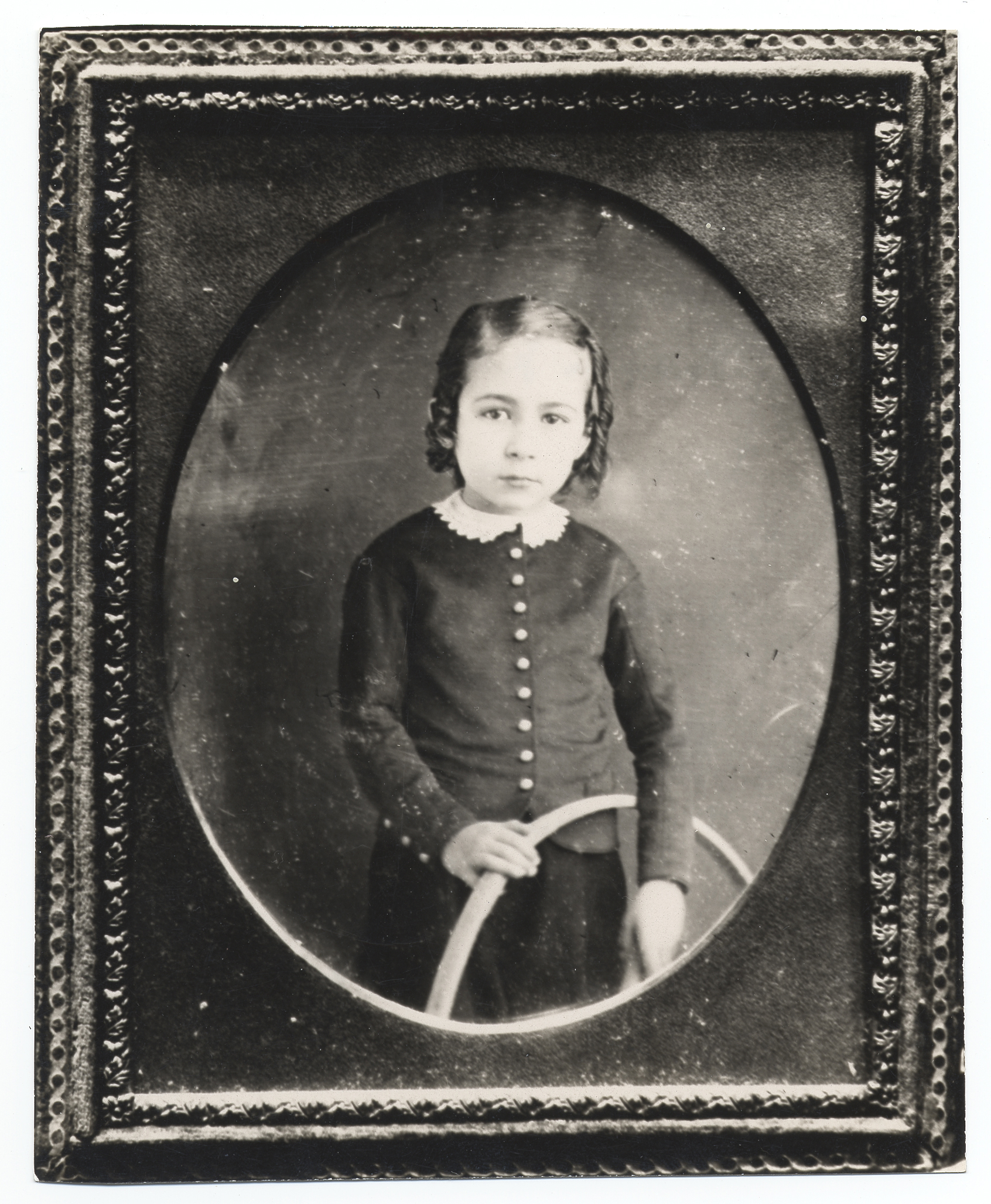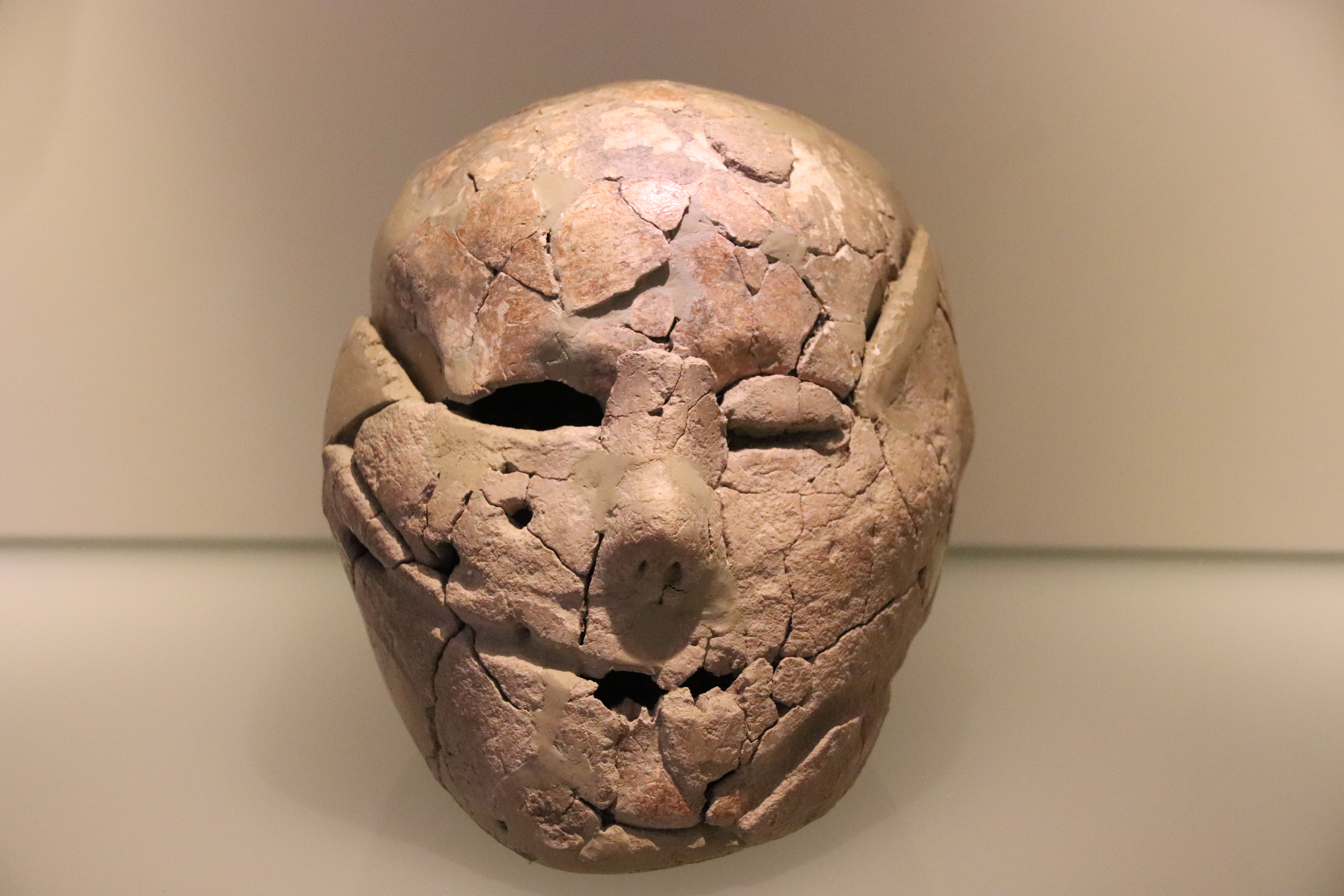|
Self-portrait (Thomas Eakins)
''Self-portrait'' is an oil on canvas painting by Thomas Eakins, presented as a diploma piece upon his election as an Associate member of the National Academy of Design in 1902. Although Eakins included himself as an observer or participant in group portraits and genre scenes, this and a smaller unsigned and undated oil, thought to have been made at about the same time, are the only unadorned self-portraits he ever painted. Lloyd Goodrich wrote that it "is not only one of his finest head and bust likenesses, but a revealing human document; in the direct look of his remarkable eyes one can see strength, penetrating intelligence, and a touch of ironic humor."Goodrich, Vol. II, 1982. p. 201. Background Largely due to controversies surrounding his work, Eakins was not invited to become a member of the National Academy of Design until 1902, well after many of his contemporaries. It was only in the late 1890s that his reputation benefited from a positive reassessment by his colleagues, ... [...More Info...] [...Related Items...] OR: [Wikipedia] [Google] [Baidu] |
Thomas Eakins
Thomas Cowperthwait Eakins (; July 25, 1844 – June 25, 1916) was an American realist painter, photographer, sculptor, and fine arts educator. He is widely acknowledged to be one of the most important American artists. For the length of his professional career, from the early 1870s until his health began to fail some 40 years later, Eakins worked exactingly from life, choosing as his subject the people of his hometown of Philadelphia. He painted several hundred portraits, usually of friends, family members, or prominent people in the arts, sciences, medicine, and clergy. Taken ''en masse'', the portraits offer an overview of the intellectual life of contemporary Philadelphia; individually, they are incisive depictions of thinking persons. In addition, Eakins produced a number of large paintings that brought the portrait out of the drawing room and into the offices, streets, parks, rivers, arenas, and surgical amphitheaters of his city. These active outdoor venues allo ... [...More Info...] [...Related Items...] OR: [Wikipedia] [Google] [Baidu] |
National Academy Of Design
The National Academy of Design is an honorary association of American artists, founded in New York City in 1825 by Samuel Morse, Asher Durand, Thomas Cole, Martin E. Thompson, Charles Cushing Wright, Ithiel Town, and others "to promote the fine arts in America through instruction and exhibition." Membership is limited to 450 American artists and architects, who are elected by their peers on the basis of recognized excellence. History The original founders of the National Academy of Design were students of the American Academy of the Fine Arts. However, by 1825 the students of the American Academy felt a lack of support for teaching from the academy, its board composed of merchants, lawyers, and physicians, and from its unsympathetic president, the painter John Trumbull. Samuel Morse and other students set about forming "the drawing association", to meet several times each week for the study of the art of design. Still, the association was viewed as a dependent organizati ... [...More Info...] [...Related Items...] OR: [Wikipedia] [Google] [Baidu] |
Lloyd Goodrich
Lloyd Goodrich (July 10, 1897March 27, 1987) was an American art historian. He wrote extensively on American artists, including Edward Hopper, Thomas Eakins, Winslow Homer, Raphael Soyer and Reginald Marsh. He was associated with the Whitney Museum of American Art in New York City for many years. Life and career During his childhood in Nutley, New Jersey, Goodrich was a close friend of Reginald Marsh, who would later become an important painter. Initially Goodrich considered a career as an artist. He studied painting and drawing at the Art Students League of New York with Kenneth Hayes Miller from 1913-1915. Between late 1915 and summer 1916, he studied with Douglas Volk at the National Academy of Design The National Academy of Design is an honorary association of American artists, founded in New York City in 1825 by Samuel Morse, Asher Durand, Thomas Cole, Martin E. Thompson, Charles Cushing Wright, Ithiel Town, and others "to promote the f .... In 1916 Goodrich returne ... [...More Info...] [...Related Items...] OR: [Wikipedia] [Google] [Baidu] |
The Swimming Hole
''The Swimming Hole'' (also known as ''Swimming'' and ''The Old Swimming Hole'') is an 1884–85 painting by the American artist Thomas Eakins (1844–1916), Goodrich catalog #190, in the collection of the Amon Carter Museum of American Art in Fort Worth, Texas. Executed in oil on canvas, it depicts six men swimming naked in a lake, and is considered a masterpiece of American painting. According to art historian Doreen Bolger it is "perhaps Eakins' most accomplished rendition of the nude figure", and has been called "the most finely designed of all his outdoor pictures". Since the Renaissance, the human body has been considered both the basis of artists' training and the most challenging subject to depict in art, and the nude was the centerpiece of Eakins' teaching program at the Pennsylvania Academy of the Fine Arts. For Eakins, this picture was an opportunity to display his mastery of the human form. In this work, Eakins took advantage of an exception to the generally prud ... [...More Info...] [...Related Items...] OR: [Wikipedia] [Google] [Baidu] |
The Agnew Clinic
''The Agnew Clinic'' (or ''The Clinic of Dr. Agnew'') is an 1889 oil painting by American artist Thomas Eakins. It was commissioned to honor anatomist and surgeon David Hayes Agnew, on his retirement from teaching at the University of Pennsylvania. Background ''The Agnew Clinic'' depicts Dr. Agnew performing a partial mastectomy in a medical amphitheater. He stands in the left foreground, holding a scalpel. Also present are Dr. J. William White, applying a bandage to the patient; Dr. Joseph Leidy (nephew of paleontologist Joseph Leidy), taking the patient's pulse; and Dr. Ellwood R. Kirby, administering anesthetic. In the background, the operating room nurse, Mary Clymer, and University of Pennsylvania medical school students observe. One of the students is William Henry Furness III, sitting in the back row with his head cocked 90 degrees. Eakins placed himself in the painting – he is the rightmost of the pair behind the nurse – although the actual painting of him is att ... [...More Info...] [...Related Items...] OR: [Wikipedia] [Google] [Baidu] |
The Gross Clinic
''The Gross Clinic'' or ''The Clinic of Dr. Gross'' is an 1875 painting by American artist Thomas Eakins. It is oil on canvas and measures by . The painting depicts Dr. Samuel D. Gross, a seventy-year-old professor dressed in a black frock coat, lecturing a group of Jefferson Medical College students. Included among the group is a self-portrait of Eakins, who is seen at the right-hand side of the painting, next to the tunnel railing, with a white cuffed sleeve sketching or writing. Seen over Dr. Gross's right shoulder is the clinic clerk, Dr. Franklin West, taking notes on the operation. Eakins's signature is painted on the front of the surgical table. Description Admired for its uncompromising realism, ''The Gross Clinic'' has an important place documenting the history of medicine—both because it honors the emergence of surgery as a healing profession (in previous years surgery was associated primarily with amputation, which caused severe medical complications, sometimes ... [...More Info...] [...Related Items...] OR: [Wikipedia] [Google] [Baidu] |
William Rush And His Model
''William Rush and His Model'' is the collective name given to several paintings by Thomas Eakins, one set from 1876–77 and the other from 1908. These works depict the American wood sculptor William Rush in 1808, carving his statue ''Water Nymph and Bittern'' for a fountain at Philadelphia's first waterworks. The water nymph is an allegorical figure representing the Schuylkill River, which provided the city's drinking water, and on her shoulder is a bittern, a native waterbird related to the heron. Hence, these Eakins works are also known as ''William Rush Carving His Allegorical Figure of the Schuylkill River''. ''Nymph and Bittern'' Philadelphia's first waterworks was located at Centre Square, now the site of Philadelphia City Hall. Steam engines drew drinking water from the Schuylkill River and pumped it up to tanks in the engine house tower, from which it was distributed by gravity through underground mains to the city. Rush, a carver of ship figureheads, was commissione ... [...More Info...] [...Related Items...] OR: [Wikipedia] [Google] [Baidu] |
Eakins Self Portrait
Eakins is an English surname. People with this name include: * Dallas Eakins (born 1967), Canadian ice hockey defenseman and head coach *Jim Eakins (born 1946), American basketball player *John Eakins (1923/4–1998), Canadian politician *Peter Eakins (born 1947), Australian rules footballer *Susan Macdowell Eakins (1851–1938), American artist, wife of Thomas Eakins * Thomas Eakins (1844–1916), American artist See also *Eakin Eakin is an English surname. Notable people with the surname include: *Bruce Eakin, Canadian ice-hockey player *Chris Eakin, British newsreader *Cody Eakin, Canadian ice-hockey player *Douglas Holtz-Eakin, American economist * Harvey Eakin, former ... {{surname English-language surnames ... [...More Info...] [...Related Items...] OR: [Wikipedia] [Google] [Baidu] |
John Updike
John Hoyer Updike (March 18, 1932 – January 27, 2009) was an American novelist, poet, short-story writer, art critic, and literary critic. One of only four writers to win the Pulitzer Prize for Fiction more than once (the others being Booth Tarkington, William Faulkner, and Colson Whitehead), Updike published more than twenty novels, more than a dozen short-story collections, as well as poetry, art and literary criticism and children's books during his career. Hundreds of his stories, reviews, and poems appeared in ''The New Yorker'' starting in 1954. He also wrote regularly for '' The New York Review of Books''. His most famous work is his "Rabbit" series (the novels '' Rabbit, Run''; ''Rabbit Redux''; '' Rabbit Is Rich''; '' Rabbit at Rest''; and the novella '' Rabbit Remembered''), which chronicles the life of the middle-class everyman Harry "Rabbit" Angstrom over the course of several decades, from young adulthood to death. Both ''Rabbit Is Rich'' (1981) and ''Rabbit ... [...More Info...] [...Related Items...] OR: [Wikipedia] [Google] [Baidu] |
Portrait Of Leslie W
A portrait is a painting, photograph, sculpture, or other artistic representation of a person, in which the face and its expressions are predominant. The intent is to display the likeness, personality, and even the mood of the person. For this reason, in photography a portrait is generally not a snapshot, but a composed image of a person in a still position. A portrait often shows a person looking directly at the painter or photographer, in order to most successfully engage the subject with the viewer. History Prehistorical portraiture Plastered human skulls were reconstructed human skulls that were made in the ancient Levant between 9000 and 6000 BC in the Pre-Pottery Neolithic B period. They represent some of the oldest forms of art in the Middle East and demonstrate that the prehistoric population took great care in burying their ancestors below their homes. The skulls denote some of the earliest sculptural examples of portraiture in the history of art. Historical portraitur ... [...More Info...] [...Related Items...] OR: [Wikipedia] [Google] [Baidu] |
1902 Paintings
Nineteen or 19 may refer to: * 19 (number), the natural number following 18 and preceding 20 * one of the years 19 BC, AD 19, 1919, 2019 Films * ''19'' (film), a 2001 Japanese film * ''Nineteen'' (film), a 1987 science fiction film Music * 19 (band), a Japanese pop music duo Albums * ''19'' (Adele album), 2008 * ''19'', a 2003 album by Alsou * ''19'', a 2006 album by Evan Yo * ''19'', a 2018 album by MHD * ''19'', one half of the double album '' 63/19'' by Kool A.D. * '' Number Nineteen'', a 1971 album by American jazz pianist Mal Waldron * ''XIX'' (EP), a 2019 EP by 1the9 Songs * "19" (song), a 1985 song by British musician Paul Hardcastle. * "Nineteen", a song by Bad4Good from the 1992 album ''Refugee'' * "Nineteen", a song by Karma to Burn from the 2001 album ''Almost Heathen''. * "Nineteen" (song), a 2007 song by American singer Billy Ray Cyrus. * "Nineteen", a song by Tegan and Sara from the 2007 album '' The Con''. * "XIX" (song), a 2014 song by Slip ... [...More Info...] [...Related Items...] OR: [Wikipedia] [Google] [Baidu] |
Portraits By Thomas Eakins
A portrait is a painting, photograph, sculpture, or other artistic representation of a person, in which the face and its expressions are predominant. The intent is to display the likeness, personality, and even the mood of the person. For this reason, in photography a portrait is generally not a snapshot, but a composed image of a person in a still position. A portrait often shows a person looking directly at the painter or photographer, in order to most successfully engage the subject with the viewer. History Prehistorical portraiture Plastered human skulls were reconstructed human skulls that were made in the ancient Levant between 9000 and 6000 BC in the Pre-Pottery Neolithic B period. They represent some of the oldest forms of art in the Middle East and demonstrate that the prehistoric population took great care in burying their ancestors below their homes. The skulls denote some of the earliest sculptural examples of portraiture in the history of art. Historical ... [...More Info...] [...Related Items...] OR: [Wikipedia] [Google] [Baidu] |


.jpg)





